Pathogenic Microorganisms - PowerPoint PPT Presentation
Human microflora is the result of mutual adaptation of micro- and macroorganism. Most of the bacteria permanent microflora human body adapted to life in certain parts of it. In addition, there are microbes that make up a non-permanent (random) microflora. Microorganisms enter the human body with water, food, various items, from the air.
The surface of human skin contains great amount microbes. It has been calculated that when we bathe, we wash off approximately 2.5 billion different microorganisms from the surface of our skin. Sarcins, molds and yeasts, diphtheroids, as well as some pathogenic and opportunistic bacteria (staphylococci, streptococci) live on our skin. Their nutrition is provided by secretions of fatty and sebaceous glands, dead cells and decay products.
The microflora of the oral cavity is extremely diverse. Suitable temperature, alkaline reaction of saliva, food residues are favorable conditions for the development of a wide variety of microorganisms. Almost all people in oral cavity inhabited by micrococci, streptococci, staphylococci, spore and non-spore bacilli, vibrios, spirochetes, spirilla, acidophilus bacillus, yeast, actinomycetes, etc.
The human respiratory organs do not have a permanent microflora. A person, along with the air, inhales a huge amount of dust particles and microorganisms adsorbed in them. The number of microbes in the inhaled air is 200-500 times greater than in the exhaled air. Most of them linger in the nasal cavity and only a small part penetrates into the bronchi. In the upper respiratory tract(nasopharynx, pharynx) contains several relatively permanent species microbes (staphylococci, streptococci, diphtheroids, pentococci, etc.).
Very abundant microflora gastrointestinal tract especially the parts of the large intestine. Violation of the qualitative and quantitative composition of the intestinal microflora and the violation of the biological balance between pathogenic and beneficial microflora in the body as a whole and in the intestine in particular is denoted by the term dysbacteriosis. With dysbacteriosis, the body cannot fully absorb food: food is not good for a person.
Unextracted and undigested products ferment and rot, poisonous substances (endotoxins) appear that are absorbed from the intestines into the blood, leading to continuous poisoning and overstrain of the body, which constantly needs strength to fight intoxication. The overall vitality of the body decreases. Metabolism is disturbed, immunity is reduced, the body exists at the limit of its capabilities. The slightest disease-provoking factors are enough to cause chronic inflammation - the basis of many diseases.
Microbiological indicators and standards characterizing the sanitary and epidemiological state of water, air, hand washings, inventory, equipment, etc.
In accordance with hygienic safety requirements in food products and food raw materials, in food and biologically active additives, in drinking water(water supply, artesian, well), in environmental objects (wastewater, soil, air, washouts), oral hygiene products, the following microbiological indicators are determined:
1. Sanitary demonstration:
1. number of mesophilic aerobic and facultative anaerobic microorganisms (QMAFAnM),
2. bacteria of the Escherichia coli group (BGKP - coliforms),
3. bacteria of the family Enterobacteriaceae,
4. enterococci;
2. Conditionally pathogenic microorganisms:
3. bacteria of the genus Proteus,
5. sulfite-reducing clostridia,
6. Vibrio parahaemolyticus;
3. Pathogenic microorganisms:
1. salmonella,
2. Listeria monocytogenes;
4. Spoilage microorganisms:
1. yeasts and molds,
2. lactic acid microorganisms;
5. Microorganisms of starter microflora and probiotic microorganisms (in products with a normalized level of biotechnological microflora in probiotic products):
1. lactic acid microorganisms,
2. yeast,
3. bifidobacteria,
4. acidophilic bacteria, etc.
Topic 1.3. pathogenic microorganisms
Pathogenic microorganisms, their biological characteristics.
Plan
1. Pathogenic microorganisms, the concept and their properties. Infections: concept, sources. Ways of penetration pathogenic microorganisms in the human body, food. Bacteriocarrier.
2. The protective forces of the human body. Immunity, its types. Vaccines and serums.
3. Microbiological control at public catering enterprises as a means of preventing foodborne diseases.
Pathogenic microorganisms, the concept and their properties. Infections: concept, sources. Ways of penetration of pathogenic microorganisms into the human body, food. Bacteriocarrier.
Microbes that can cause diseases in humans, animals and plants are called pathogens or pathogens.
An infectious process is a historically established interaction between a susceptible human body and a pathogenic microorganism under certain conditions of the external and social environment, the extreme degree of which is an infectious disease.
For the emergence and development infectious process needed:
The presence of a pathogenic microbe.
its penetration into a susceptible organism.
Certain conditions of the external environment in which the interaction between the microorganism and the macroorganism takes place.
Conditionally pathogenic microorganisms - live on the skin, in the intestines, respiratory tract, genitourinary organs. Under normal physiological conditions of life, these microbes do not cause disease, but when the body is overworked, overheated, cooled, intoxicated, ionizing radiation, they become capable of causing a number of diseases - autoinfections.
Properties of pathogenic microorganisms:
strong specificity- each type of microbes can cause only a certain disease with its characteristic symptoms.
pathogenicity- the potential ability of a certain type of microbes to take root in a macroorganism, multiply and cause a certain disease.
virulence- indicates the degree of pathogenic action of the microbe.
ability to produce toxins- the ability of pathogenic microorganisms to produce toxic substances - toxins. Entering the blood or lymph, they affect internal organs and cause poisoning of the body of varying degrees. They can be of two types: exo- and endotoxins. Exotoxins are released into the environment by microbes during their lifetime; they are highly toxic to a living organism. Under the influence of heat and light, they are easily destroyed, and under the influence of some chemical substances lose their toxicity. Endotoxins are strongly associated with the body of the microbial cell and are released after its death and destruction. They are less toxic, highly resistant to action. high temperatures, do not lose their toxicity even when boiled.
The incubation period is a certain period of time from the moment of the introduction of a pathogenic microbe until the first signs of the disease appear.
Phenomenon bacteriocarrier occurs when treatment is stopped before complete recovery; with improper treatment; sometimes with self-healing of a mild disease that went unnoticed.
Ways of transmission of infection from a sick person to a healthy person:
Fecal-oral (through water, air, soil, food, contaminated hands, household items, etc.);
Airborne (through the air, in which microbes are in the form of aerosols - when sneezing, coughing);
Air-dust (with dust);
transmission - carriers of infections are some insects (ticks, fleas, lice, mosquitoes, flies) and rodents.
infectious process.
Doctrine of infection considers the properties of microbes that allow them to exist in the macroorganism and exert a pathogenic effect on it, taking into account the protective and adaptive reactions of the macroorganism at all stages of the development of the disease.
term "infection" or " infectious process" denote a set of physiological and pathological regenerative-adaptive reactions that occur in a susceptible organism under certain environmental conditions as a result of its interaction with pathogenic or opportunistic bacteria, fungi and viruses that have penetrated and multiply in it and are aimed at maintaining the constancy of the internal environment of the macroorganism ( homeostasis). A similar process caused by protozoa, helminths or insects is called invasion .
to the protein group bacterial toxins include thermolabile and thermostable proteins formed by gram + and gram - pathogenic bacteria with aerobic and anaerobic metabolism. These are enzymes that have their damaging effect on the macroorganism in extremely small quantities. They can be secreted by a bacterial cell into the environment, or they can be in a bound state with the cell, being released during cell autolysis.
According to the degree of connection with the bacterial cell, they are divided into three classes:
Class A- secreted into the external environment;
Class B- toxins localized in the periplasmic space, partly associated with the cell and partly secreted into the external environment. Such toxins are called mesotoxins. They do not have a signal peptide, so they are not secreted into the environment. They are released when they merge with cell membranes and exfoliate (detachment, desquamation) of cell membranes.
Class C- toxins that are firmly associated with the microbial cell and enter the environment only as a result of cell death.
By structure, protein toxins are divided into simple And complex.
Simple toxins are formed in the form of a single polypeptide chain or protoxin, functionally inactive, which, under the action of proteases of the microbe itself or proteases of representatives of normal microflora or proteases of cells and tissues of the macroorganism, is converted into an active V-A structure . Part B does not have toxicity. It's natural toxoid or toxoid, which, performing a transport function, interacts with a specific receptor on a eukaryotic cell and, forming a channel in its cytoplasmic membrane, causes the penetration of toxic group A or activator. It is toxic only in the presence of group B, which ensures the specificity and organotropic action of the toxin.
Complex toxins represent a ready-made bifunctional structure consisting of one or more groups B connected to group A. Subunits A and B are synthesized independently in the cell and subsequently combined into a single complex.
The mechanism of action of protein toxins at the macromolecular level consists of several stages.
In view of that that protein toxins are high-molecular compounds and do not independently penetrate cell membranes, their dissociation is necessary. On first stage protein toxin, due to its boarding molecules B, is fixed on the cell surface, interacting with specific receptors of various chemical nature, which leads to the formation of a complex toxin receptor .
During second stage there is an activation of the toxin under the action of proteases by the type of limited proteolysis, followed by the formation of a bifunctional A-B structure. A change in the conformational structure of the toxin molecule leads to the opening of its catalytic center and the appearance of enzymatic activity. Third stage consists in the transmembrane translocation of part A into the cytoplasm of the cell, where it disrupts vital biochemical processes in the cell, acting on its specific targets.
The high receptor specificity of part B and the high selectivity of part A catalysis together cause action specificity protein toxin.
Bacterial toxins they are similar in structure and a number of other properties to macroorganism signal molecules: hormones, neurotransmitters, interferons, etc. In the course of ligand-receptor interaction with macroorganism cells, they use ready-made structures involved in neurohumoral signaling. Being antimetabolites of signal molecules of the macroorganism, they initially imitate their action, and then have a blocking effect.
The versatility of protein toxins lies in their polyfunctionality , and is not limited to their significance only as pathogenicity factors. Their formation plays a significant role in the ecology of bacteria, their existence in natural biocenoses. Due to the similarity of the structure with bacteriocins, they have toxic effect on competitors, including representatives of the normal microflora of the macroorganism. Possessing enzymatic activity, they perform the trophic function of the life support of the microbial cell.
Protein bacterial toxins are complete thymus-dependent antigens, to them are formed antitoxins- specific antibodies that neutralize them. From protein toxins can be obtained toxoids, i.e. toxins without toxic properties, but retained their antigenic properties, which is used during vaccination and serotherapy.
When using antitoxic serums it is necessary to take into account the fact that a protein toxin can be neutralized by antibodies only when it is in the blood or lymph, as well as on the cell surface. Specific antibodies block the interaction of the toxin with specific receptors, disrupt the process of dissociation of the toxin-receptor complex and translocation of part A into the cytoplasm of the target cell. Antibodies do not penetrate through the cell membrane and cannot neutralize the translocated part A, which explains the lack of effect of serotherapy with untimely treatment.
According to the mechanism of action, protein bacterial toxins are divided into five groups:
- damaging cell membranes;
protein synthesis inhibitors;
Activating metabolic pathways controlled by second messengers (messengers);
1. Pathogenic microorganisms: concept, biological features, specificity, virulence, toxicity.

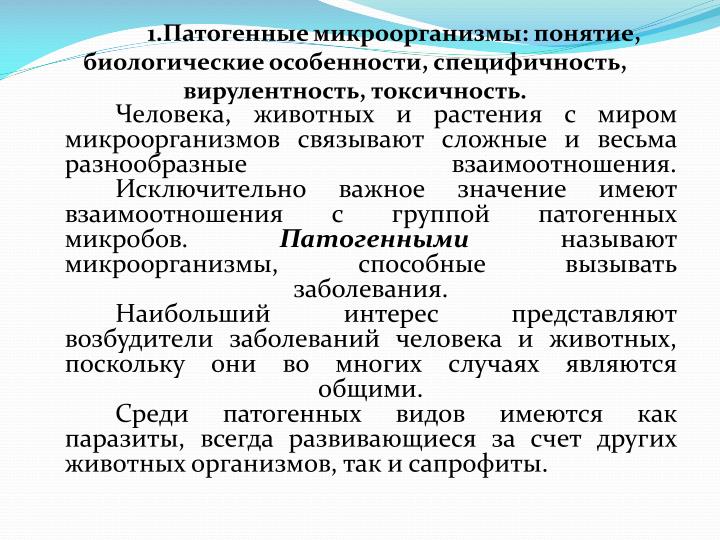
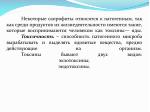
Pathogenic, since among the products of their vital activity there are those that are perceived by humans as toxins-poisons. Toxicity is the ability of a pathogenic microbe to produce and release toxic substances that have a harmful effect on the body. There are two types of toxins: exotoxins and endotoxins.
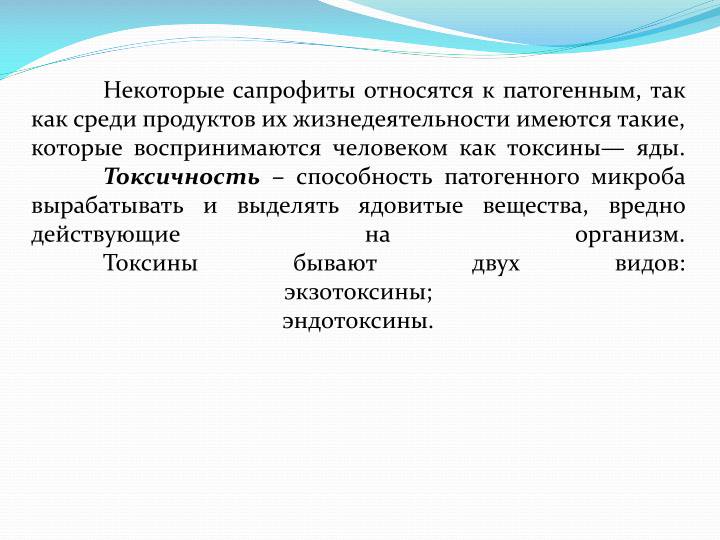
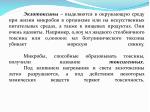
Pathogenic, since among the products of their vital activity there are those that are perceived by humans as toxins-poisons. are released into the environment during the life of microbes in the body or on artificial nutrient media, as well as in food products. They are very poisonous. For example, 0.005 ml of liquid tetanus toxin or 0.0000001 ml of botulinum toxin will kill a guinea pig. Microbes that can form toxins are called toxigenic. Under the influence of heat and light, exotoxins are easily destroyed, and under the action of certain chemicals they lose their toxicity.
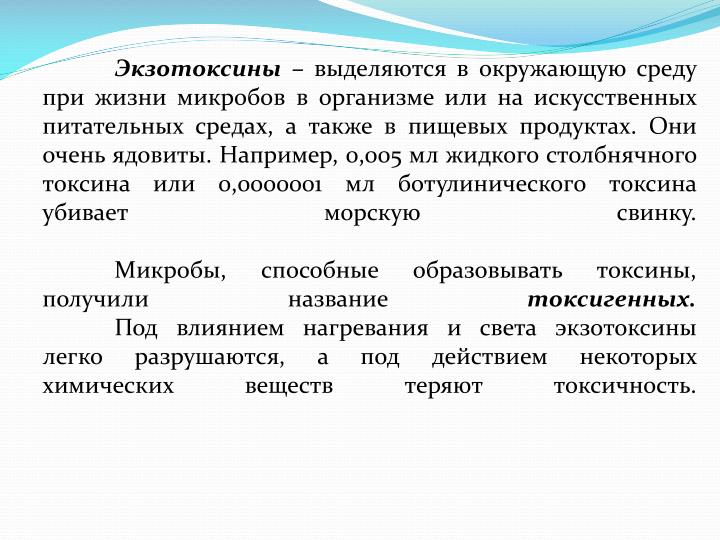
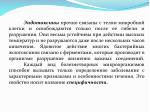
Pathogenic, since among the products of their vital activity there are those that are perceived by humans as toxins-poisons. are strongly associated with the body of the microbial cell and are released only after its death and destruction. They are very stable at high temperatures and do not break down even after several hours of boiling. The toxic effect of many bacterial exotoxins is associated with enzymes that destroy vital compounds in the body. Each type of pathogenic microorganisms can cause only a certain disease with characteristic features and flow characteristics. This property is called specificity.
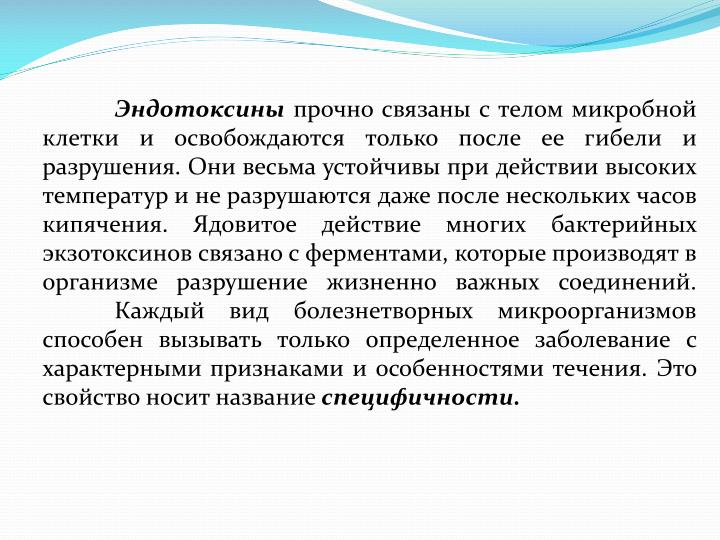
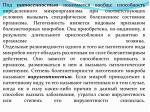
Pathogenic, since among the products of their vital activity there are those that are perceived by humans as toxins-poisons. Pathogenicity is generally understood as the ability of a certain microorganism, under appropriate conditions, to cause a specific disease state of the body. Pathogenicity is a species trait pathogenic microbes. It is acquired, apparently, as a result of a long adaptation to development in the host organism. Separate varieties of the same pathogenic microbial species may have a pathogenic effect of different strength. It depends on the ability to penetrate the body, multiply in it and cause pathological changes. The degree of pathogenicity of a pathogenic microbe is called virulence. If the microbe belongs to a pathogenic species, then it is called pathogenic and in the case when, for some reason, it is not able to cause a disease at the moment, it has lost its virulence or its degree of virulence has decreased.
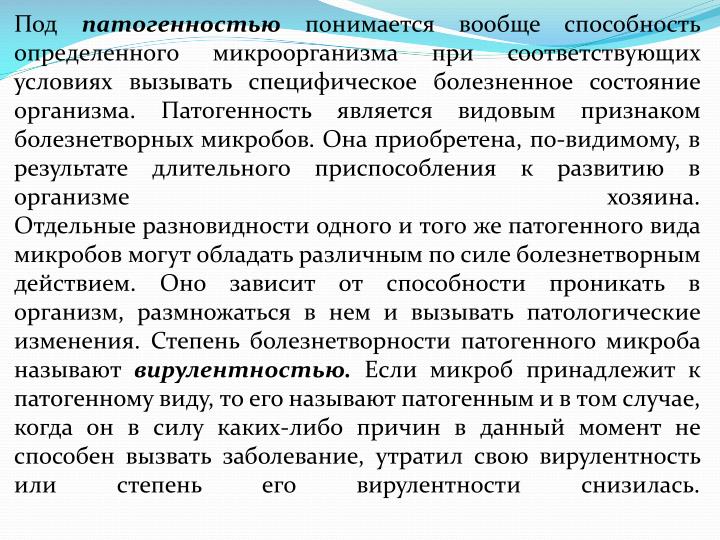
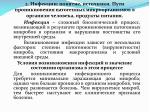
Ways of penetration of pathogenic microorganisms into the human body, food.
Infection is a complex biological process that occurs as a result of the penetration of pathogenic microbes into the body and the violation of the constancy of its internal environment.
The occurrence of infection depends on several factors: the degree of pathogenicity (virulence) of the microbe, the state of the macroorganism and environmental conditions.
Conditions for the occurrence of infections and the significance of the state of the body in this process
For the occurrence of an infectious process, a minimally infectious dose of the microbe is required; however, the more microbes have entered the body, the sooner the disease develops. The more virulent the microbe, the faster everything comes Clinical signs illness.
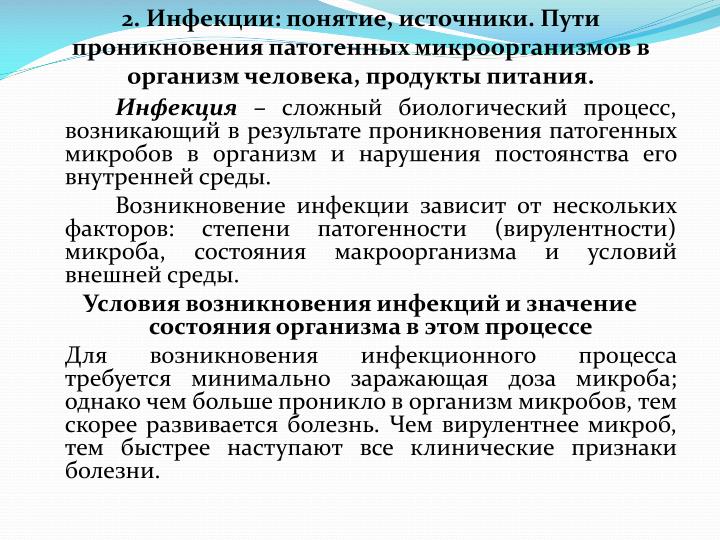
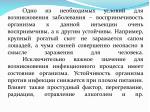
The occurrence of the disease - the susceptibility of the body to a given injection is very susceptible, but resistant to others. For example, cattle are not infected with horse glanders, and swine fever is completely harmless in terms of infection for humans. The state of the body is of exceptional importance for the occurrence of an infectious process. The body's resistance to infection is reduced by poor nutrition. The cold factor, overheating, radiation, alcohol poisoning, etc., also affect.
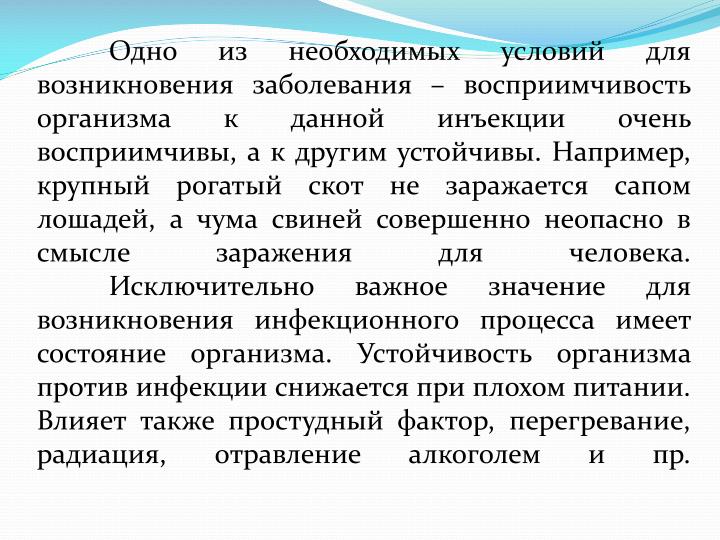
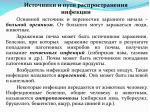
Spread of infection
The main source and carrier of the infectious principle is a sick organism. People and animals can become infected from the patient.
Infected soil can be a source of infection. Diseases in which infection occurs as a result of the entry of pathogenic microbes from the soil are called soil infections ( anthrax, gas gangrene, etc.). Soil can be a source of pathogenic microbes entering food.
The causative agent of infections is also transmitted through the air. Such an infection is called aerogenic. It can be dust and drip.
Some infections are transmitted from animals to humans. infectious diseases, common man and animals are called anthropozoonoses (anthrax, tuberculosis, brucellosis, rabies, foot and mouth disease, swine erysipelas, etc.).
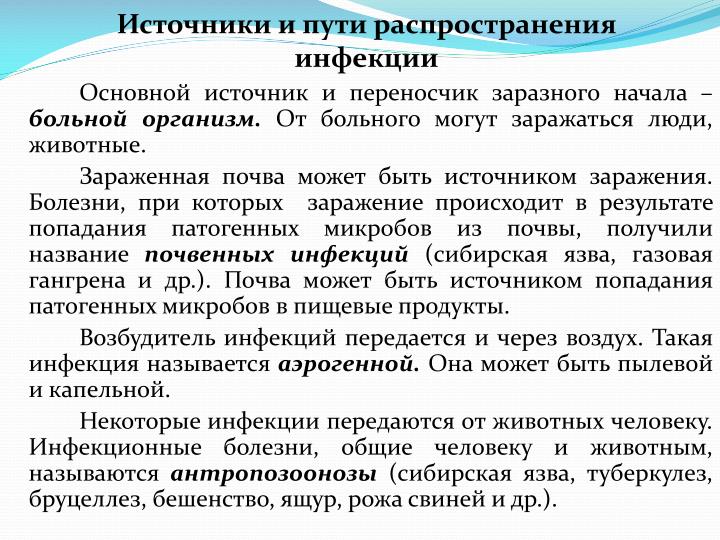
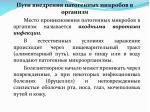
Microbes in the body
The place of penetration of pathogenic microbes into the body is called the entrance gate of infection.
Under natural conditions, infection occurs through digestive tract(alimentary route), when pathogenic microorganisms enter food or water.
The pathogen can penetrate through damaged, and in some cases infectious diseases(brucellosis) and intact mucous membranes of the mouth, nose, eyes, urinary tract and skin.
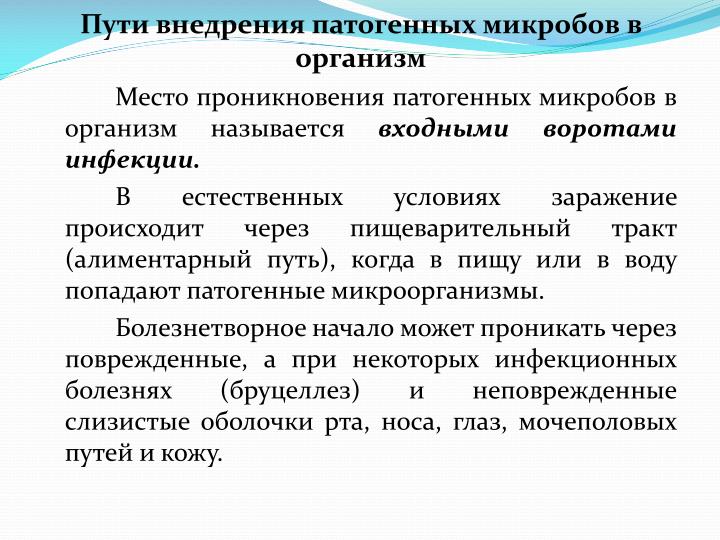
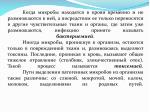
They do not temporarily multiply in it, but through it they are only transferred to other sensitive tissues and organs, where they then multiply, the infection is usually called bacteremia. Sometimes microbes, having penetrated into the body, remain only in the damaged tissue and, multiplying, release toxins. The latter, penetrating into the blood, cause general severe poisoning (tetanus, malignant edema). This process is called toxemia. The ways of excreting pathogenic microbes from the body are also different: with saliva, sputum, urine, feces, milk, secretions from the birth canal.
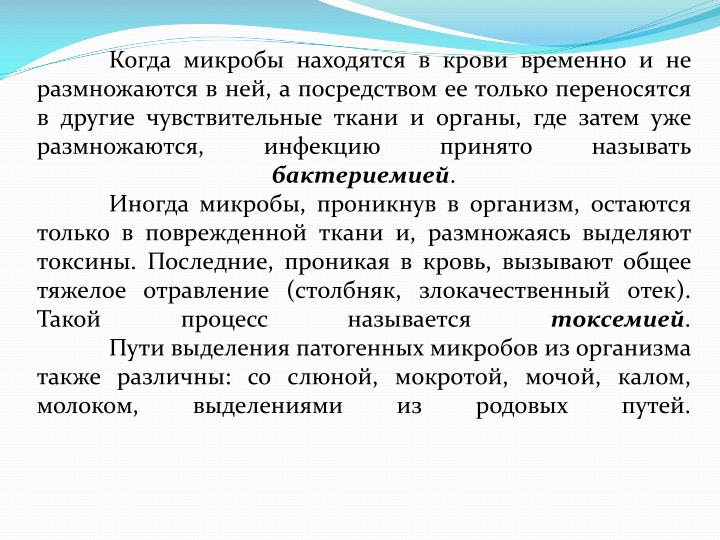
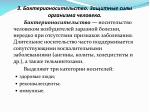
Defense forces of the human body.
Bacteriocarrier - carriage by a person of pathogens of an infectious disease, often in the absence of signs of the disease. Long-term carriage is often supported by concomitant inflammatory diseases(tonsillitis, colitis, cholecystitis, etc.), as well as helminthiases.
- healthy people;
- convalescents;
- immune.
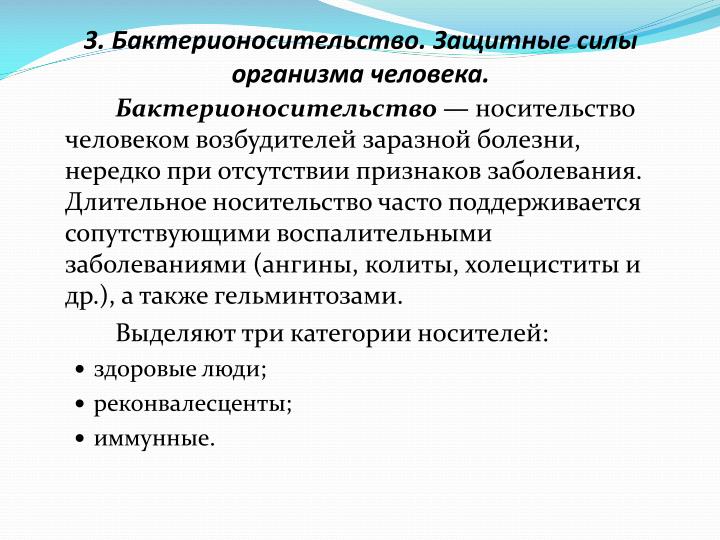
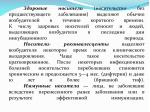
The protective forces of the human body. Carriers (carriage without a previous disease) usually excrete pathogens for a short time. Healthy carriers also include people who excrete the pathogen in the last days of the incubation period. Convalescent carriers excrete the pathogen some time after clinical recovery. Most of the time this is short term. After some infectious diseases, the carriage of those who have been ill becomes chronic and lasts 3-4 months. (diphtheria) and even 10 years or more (typhoid fever). Immune carriers are persons who do not become ill due to a previous disease or as a result of effective immunization.
